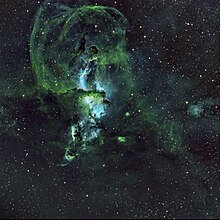| Emission nebula | |
|---|---|
 NGC 3576. Credit ESO. | |
| Observation data: J2000.0 epoch | |
| Right ascension | 11h 11m 32.7s[1] |
| Declination | −61° 21′ 44″[1] |
| Distance | 6,000[2] ly |
| Constellation | Carina |
| Physical characteristics | |
| Radius | 50 ly |
| Designations | GAL 291.30-00.7, RCW 57A, BRAN 348A, GAL 291.27-00.71, [GG70] 291.3-0.7, GAL 291.28-00.71, GUM 38a, [GS70] 291.3-00.7 |

NGC 3576 is a bright emission nebula in the Sagittarius arm of the galaxy a few thousand light-years away from the Eta Carinae nebula. It is also approximately 100 light years across and 9000 light-years away from Earth.[3] It was discovered by John Frederick William Herschel on 16 March 1834.[4] This nebula has received six different classification numbers. Currently, astronomers call the entire nebula NGC 3576. A popular nickname is "The Statue of Liberty Nebula" because of the distinctive shape in the middle of the nebula. The name was first suggested in 2009 by Dr. Steve Mazlin, a member of Star Shadows Remote Observatory (SSRO).[5] Within the nebula, episodes of star formation are thought to contribute to the complex and suggestive shapes. Powerful winds from the nebula's embedded, young, massive stars shape the looping filaments.[6]

References
[edit]- ^ a b "NASA/IPAC Extragalactic Database". Retrieved 2007-04-27.
- ^ "Atlas of the Universe". Archived from the original on 2015-07-18. Retrieved 2007-04-27.
- ^ "NGC 3576, the Statue of Liberty Nebula". 27 June 2012.
- ^ "Category:NGC 3576 - Wikimedia Commons".
- ^ "Star Shadows Remote Observatory Gallery".
- ^ "APOD: 2008 March 26 - The NGC 3576 Nebula". apod.nasa.gov. Retrieved 2021-02-11.
External links
[edit] Media related to NGC 3576 at Wikimedia Commons
Media related to NGC 3576 at Wikimedia Commons- Photo of the "Statue of Liberty"
Well, that’s interesting to know that Psilotum nudum are known as whisk ferns. Psilotum nudum is the commoner species of the two. While the P. flaccidum is a rare species and is found in the tropical islands. Both the species are usually epiphytic in habit and grow upon tree ferns. These species may also be terrestrial and grow in humus or in the crevices of the rocks.
View the detailed Guide of Psilotum nudum: Detailed Study Of Psilotum Nudum (Whisk Fern), Classification, Anatomy, Reproduction